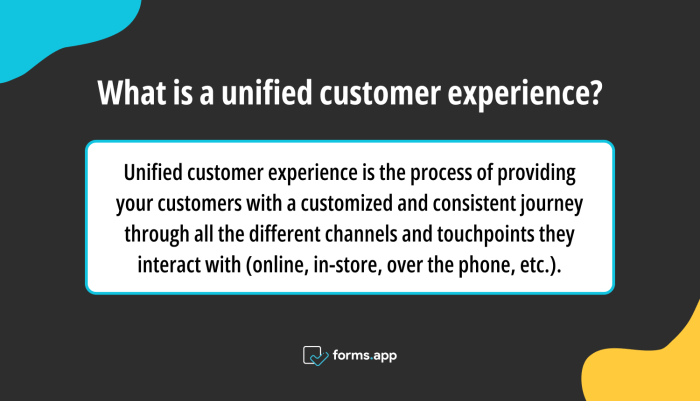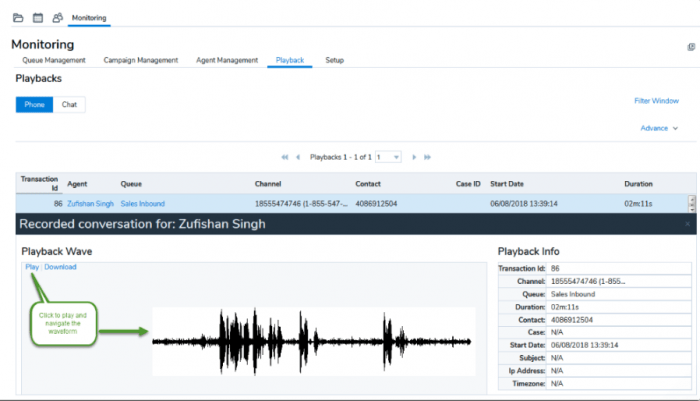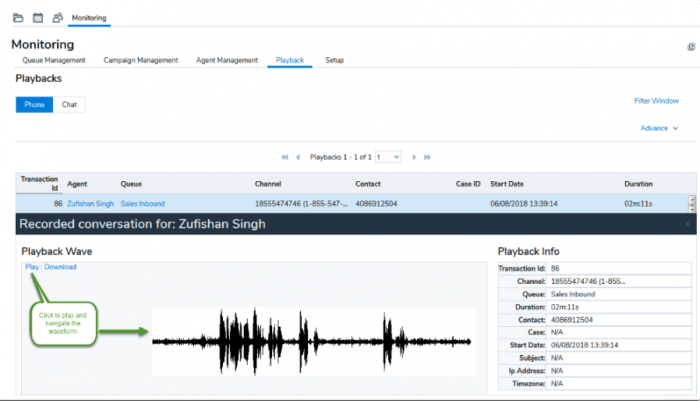Building a cohesive customer journey is crucial for success in today’s market. It’s about crafting a seamless and positive experience for your customers, from their first interaction to long-term loyalty. This guide will delve into the essential steps to achieve this, including understanding customer needs, optimizing interactions, and measuring performance.
We’ll explore the key elements of a cohesive customer journey, from defining the overall experience to analyzing customer touchpoints and ensuring consistent messaging across all channels. We’ll also discuss how to personalize interactions, gather feedback, and leverage technology to create a truly exceptional customer journey. This journey isn’t a one-time project; it’s an ongoing process of refinement and adaptation.
Defining the Customer Journey
A cohesive customer journey is more than just a series of touchpoints; it’s a carefully orchestrated experience that guides customers from initial awareness to ultimate loyalty. It’s a meticulously crafted narrative that resonates with the customer’s needs and aspirations, creating a positive and memorable impression at every stage. This seamless flow fosters trust and strengthens the brand-customer relationship.A cohesive customer journey ensures that every interaction, from initial browsing to post-purchase support, aligns with the overall brand message and promises.
This consistency creates a unified brand perception, reinforcing customer confidence and encouraging repeat business. This approach is particularly vital in today’s competitive market, where customers are constantly bombarded with choices and expect personalized and efficient interactions.
Key Elements of a Cohesive Customer Journey
Understanding the key elements of a cohesive customer journey is crucial for creating a positive and memorable experience. These elements work together to ensure a smooth and consistent experience.
- Awareness: This initial stage focuses on making the customer aware of the product or service. Effective marketing strategies, including targeted advertising and social media campaigns, are critical to raising brand visibility and generating interest. Clear messaging and a compelling brand story are essential to capture attention and position the product/service in the customer’s mind.
- Consideration: This stage involves the customer researching and evaluating different options. Providing detailed product information, user reviews, and testimonials are essential. Transparent communication about pricing and value propositions is vital to attract potential customers. User-friendly websites and easily accessible contact channels play a crucial role.
- Decision: This is the crucial moment when the customer decides to make a purchase. A streamlined and user-friendly purchasing process, secure payment options, and clear shipping information are paramount. Exceptional customer service during this stage helps to build trust and solidify the decision.
- Action: This stage involves the actual purchase and delivery of the product or service. A smooth transaction, prompt delivery, and well-packaged items are key. Following up with a thank-you note or email further enhances the customer experience.
- Retention: This critical stage focuses on fostering customer loyalty. Excellent post-purchase support, personalized recommendations, and exclusive offers for returning customers are crucial. Collecting customer feedback and acting upon it to improve the product or service demonstrates commitment and value.
Significance of a Seamless Customer Journey
In today’s market, a seamless customer journey is paramount. It allows businesses to stand out from competitors, build stronger customer relationships, and drive significant revenue growth. Customers expect personalized interactions and quick resolutions to issues. A cohesive journey, therefore, fosters customer satisfaction and loyalty, ultimately boosting brand reputation and market share.
Examples of Successful Brands with Cohesive Customer Journeys
Several brands have successfully implemented cohesive customer journeys. For example, Amazon’s intuitive website, extensive product selection, and lightning-fast delivery system create a seamless experience from browsing to delivery. Apple’s focus on sleek design, user-friendly products, and comprehensive support fosters a cohesive experience that extends beyond the initial purchase. These brands consistently deliver a positive customer journey, contributing to their success in the marketplace.
Cohesive vs. Fragmented Customer Journey
| Characteristic | Cohesive Customer Journey | Fragmented Customer Journey |
|---|---|---|
| Brand Perception | Unified and consistent brand image across all touchpoints. | Inconsistent and disjointed brand image, leading to confusion. |
| Customer Experience | Smooth and positive experience from awareness to retention. | Disjointed and frustrating experience, leading to dissatisfaction. |
| Customer Loyalty | Strong customer loyalty and repeat business. | Low customer loyalty and high churn rate. |
| Brand Reputation | Positive brand reputation and trust. | Negative brand reputation and low credibility. |
| Revenue Growth | Increased revenue and market share. | Limited revenue growth and stagnant market position. |
Identifying Customer Touchpoints

Understanding your customers’ journey isn’t just about the big picture; it’s about dissecting every interaction they have with your brand. This involves pinpointing every touchpoint, from initial awareness to post-purchase follow-up. By meticulously analyzing these touchpoints, you gain invaluable insights into how your customers perceive your brand and what adjustments you can make to enhance their experience. A clear understanding of customer touchpoints is crucial for tailoring messaging, optimizing processes, and ultimately, fostering loyalty.
Touchpoint Identification
Customer touchpoints are any point of contact between a customer and your company. These interactions can range from browsing your website to receiving a follow-up email after a purchase. Identifying all touchpoints allows you to understand the customer’s experience across the entire journey. A comprehensive list ensures no interaction is overlooked, enabling a holistic view of the customer’s relationship with your brand.
Analyzing the Customer Experience at Each Touchpoint
Evaluating the customer experience at each touchpoint involves several key aspects. First, consider the customer’s emotions and perceptions at each interaction. Was the interaction positive, negative, or neutral? Second, analyze the efficiency and effectiveness of the process. Was the information readily available?
Was the interaction seamless and intuitive? Third, examine the overall satisfaction level based on customer feedback. Collecting and analyzing this data helps you understand pain points and areas for improvement. This data-driven approach allows for targeted improvements at specific touchpoints, ultimately leading to a more positive customer experience.
Importance of Consistent Messaging Across All Touchpoints, Building a cohesive customer journey
Consistency in messaging across all touchpoints is vital for building brand recognition and trust. Imagine a customer reading a promotional email that contradicts the information presented on your website. This inconsistency creates confusion and erodes trust. Maintaining a consistent brand voice, tone, and visual identity across every interaction ensures a unified and memorable experience. This unified approach fosters brand loyalty and reinforces your company’s values.
Visual Representation of Customer Journey Map
A customer journey map visually illustrates the customer’s journey from initial awareness to post-purchase. It’s a flowchart highlighting key touchpoints, such as website visits, social media interactions, and customer service calls. The map should include information about the customer’s feelings, motivations, and expectations at each stage. A well-designed map allows for a clear understanding of the customer’s perspective, revealing areas for improvement and optimization.
This graphic representation, with clear descriptions of each touchpoint, provides a visual guide for optimizing the entire customer experience.
Types of Customer Touchpoints
A comprehensive understanding of different touchpoints is critical to crafting a cohesive customer experience. This table Artikels various types and examples, showcasing the breadth of interactions.
| Type of Touchpoint | Examples |
|---|---|
| Website Interactions | Homepage visits, product pages, blog posts, contact forms |
| Social Media Interactions | Social media posts, comments, messages, reviews |
| Marketing Emails | Promotional emails, newsletters, welcome emails, abandoned cart reminders |
| Customer Service Interactions | Phone calls, live chat sessions, email support, social media inquiries |
| In-Store Experiences | Store visits, product demonstrations, staff interactions, checkout processes |
| Product Usage | Initial setup, user manuals, online tutorials, support forums |
| Post-Purchase Follow-up | Surveys, thank-you emails, product updates, warranty information |
Understanding Customer Needs and Expectations: Building A Cohesive Customer Journey
Knowing your customers is crucial for crafting a seamless and satisfying customer journey. Understanding their specific needs, desires, and expectations across various touchpoints allows businesses to tailor experiences, anticipate problems, and ultimately, build stronger relationships. This deep understanding fuels personalized interactions, leading to increased customer loyalty and advocacy.Customer needs and expectations are not monolithic; they vary significantly based on demographics, purchasing history, and individual preferences.
Recognizing these nuances is vital to delivering experiences that resonate with each segment. Anticipating future needs and adapting to evolving preferences allows businesses to stay ahead of the curve and remain competitive. This proactive approach fosters a sense of anticipation and value for customers, leading to greater satisfaction and loyalty.
Identifying Customer Needs and Expectations Across Segments
Different customer segments have unique needs and expectations. Understanding these variations allows businesses to tailor their interactions to resonate with each group. Analyzing purchase history, browsing behavior, and feedback from various touchpoints provides valuable insights into individual preferences. Understanding these nuances allows businesses to create targeted solutions that address specific needs and expectations. For instance, a new parent may prioritize ease of use and clear instructions over advanced features.
Conversely, a seasoned tech user may expect seamless integration and extensive customization options.
Anticipating Customer Needs Throughout the Journey
Anticipating customer needs throughout the journey requires a proactive approach. By understanding the typical customer journey, businesses can identify potential pain points and proactively offer solutions. This involves monitoring customer interactions across all touchpoints and using data to predict future needs. For example, if a customer frequently cancels orders during the checkout process, businesses can investigate the reasons and implement solutions, such as providing clearer shipping options or more flexible payment methods.
Gathering Customer Feedback at Each Touchpoint
Gathering feedback at each touchpoint is essential for understanding customer sentiment and identifying areas for improvement. This can be done through surveys, feedback forms, live chat interactions, and social media monitoring. Analyzing this feedback provides insights into customer experiences at various stages of the journey. For instance, a survey after a product purchase can reveal aspects that need improvement, like packaging or delivery speed.
By analyzing this data, businesses can refine the customer journey for future interactions.
The Role of Customer Personas in Shaping the Customer Journey
Customer personas are crucial for shaping the customer journey. These detailed representations of ideal customers help businesses understand their needs, motivations, and pain points. By creating detailed customer personas, businesses can tailor their strategies to resonate with specific customer segments. Using these personas allows businesses to envision the customer experience from their perspective and create interactions that address their specific needs.
For example, a persona representing a busy professional may prioritize speed and efficiency in all interactions.
Key Needs and Expectations for Different Customer Segments
| Customer Segment | Key Needs | Key Expectations |
|---|---|---|
| First-time buyers | Clear instructions, easy navigation, and secure payment options | Fast and reliable service, responsive customer support, and a sense of trust |
| Repeat customers | Personalized recommendations, exclusive offers, and seamless re-engagement | Consistent quality, reliable service, and recognition for loyalty |
| High-value customers | Dedicated account managers, customized solutions, and priority support | Exceptional service, tailored experiences, and proactive problem-solving |
Optimizing Customer Interactions
Crafting a seamless customer journey hinges on optimizing interactions at every touchpoint. This involves understanding not just what customers want, buthow* they want it delivered. From initial contact to post-purchase support, every interaction contributes to the overall brand perception. A well-optimized journey builds trust, loyalty, and ultimately, drives business growth.Effective optimization requires a deep understanding of customer needs and expectations, combined with a strategic approach to personalization and technology integration.
Creating a seamless customer journey is key to success, but sometimes it’s tough to manage all the moving parts. That’s where outsourced marketing for professional services, like outsourced marketing for professional services 5 reasons you should ca1 , comes in. By focusing on specialized marketing strategies, you can free up your internal team to concentrate on core competencies and build a more cohesive and satisfying experience for your clients from start to finish.
By carefully considering each touchpoint and implementing targeted strategies, businesses can transform fleeting interactions into lasting customer relationships.
Strategies for Optimizing Touchpoints
Understanding the various touchpoints is crucial for optimizing customer interactions. A holistic approach ensures every interaction reinforces a positive brand image. This requires meticulous planning, proactive engagement, and continuous evaluation of the effectiveness of each touchpoint. Strategies must be flexible and adaptable to changing customer needs and preferences.
Crafting a seamless customer journey is key, but understanding your sales data is crucial. Knowing precisely how customers interact with your WooCommerce store, from browsing to buying, is vital. This means setting up WooCommerce conversion tracking, like how to setup woocommerce conversion tracking , to monitor key metrics. This detailed view helps refine your strategies for a more effective and satisfying customer experience.
- Proactive Communication: Anticipate customer needs and communicate relevant information proactively. This could involve sending personalized recommendations, offering support before a problem arises, or proactively addressing potential issues. A personalized email campaign that anticipates a customer’s likely needs based on past purchases, for example, can dramatically improve customer experience.
- Streamlined Processes: Ensure all processes, from order placement to delivery, are efficient and easy to navigate. Reduce friction points by providing clear instructions, intuitive interfaces, and multiple support channels. A user-friendly website with a clear return policy, for example, reduces frustration and strengthens the customer experience.
- Personalized Experiences: Tailor interactions to individual customer preferences and needs. This could involve offering customized product recommendations, creating personalized support experiences, or even using AI-powered chatbots to offer specific and tailored assistance. A tailored email marketing campaign that addresses specific customer interests and past interactions, for instance, can lead to higher conversion rates.
Personalization in the Customer Journey
Personalization is not a trend; it’s a necessity. Customers expect brands to understand their individual needs and preferences. This creates a sense of value and fosters a stronger connection. It’s about moving beyond generic interactions and delivering tailored experiences that resonate with the individual customer.
- Data-Driven Insights: Leverage data to understand customer behavior and preferences. This data should be used ethically and transparently to personalize interactions. Analyzing purchase history, browsing behavior, and support interactions, for example, can inform the development of personalized recommendations and support strategies.
- Tailored Recommendations: Provide relevant and timely recommendations based on past purchases, browsing history, and expressed interests. This can significantly improve conversion rates and customer satisfaction. A personalized product recommendation email, for instance, could lead to increased sales and customer engagement.
- Customized Support: Offer tailored support solutions that address individual customer needs. This could involve providing specialized FAQs, creating customized support channels, or offering one-on-one support sessions. A customer support system that remembers a customer’s past interactions and provides personalized troubleshooting solutions is a clear example of a tailored support experience.
Technology in Enhancing Customer Interactions
Technology plays a pivotal role in optimizing customer interactions and creating a seamless journey. Advanced tools can automate tasks, personalize experiences, and improve communication channels. From chatbots to AI-powered recommendations, technology offers powerful tools to elevate customer service.
- Automation: Utilize automation to streamline processes, handle routine tasks, and provide instant responses. Automating order confirmations, email marketing, and even initial support queries can significantly improve customer satisfaction. Automated responses, for instance, can significantly reduce response times for customers.
- AI-Powered Tools: Employ AI for personalized recommendations, predictive analytics, and chatbots. These tools can anticipate customer needs, offer proactive support, and provide customized experiences. AI-powered chatbots, for instance, can offer instant answers to frequently asked questions, significantly reducing wait times.
- Data Analytics: Utilize data analytics to track customer interactions, measure performance, and identify areas for improvement. Analyzing data, for instance, can identify patterns in customer behavior and preferences, allowing businesses to personalize experiences even further.
Best Practices for Improving Customer Interactions
| Touchpoint | Best Practice |
|---|---|
| Website | Intuitive navigation, clear calls to action, personalized product recommendations. |
| Relevant content, timely delivery, clear unsubscribe options. | |
| Social Media | Proactive engagement, responsive customer service, personalized interactions. |
| Customer Service | Prompt responses, personalized solutions, clear communication channels. |
Measuring and Analyzing Customer Journey Performance
Understanding your customer journey is crucial, but truly knowing its effectiveness requires careful measurement and analysis. This phase allows you to pinpoint areas where the journey excels and identify those needing improvement, ultimately leading to a more satisfying and efficient customer experience. Tracking key metrics and utilizing data analysis tools provide invaluable insights, fostering continuous improvement and driving business growth.The ability to accurately measure and analyze the customer journey performance is critical for identifying areas for improvement and ensuring that the customer experience aligns with business goals.
By understanding how customers interact with your brand at each touchpoint, you can optimize processes, personalize interactions, and enhance overall satisfaction.
Methods for Measuring Customer Journey Effectiveness
Various methods can be employed to gauge the effectiveness of a cohesive customer journey. These methods go beyond simple surveys and encompass a broader spectrum of data collection and analysis. Quantitative and qualitative data are combined to create a comprehensive understanding. Metrics encompassing satisfaction, engagement, and conversion rates are crucial to assess the effectiveness of the customer journey.
Tracking Key Metrics for Customer Satisfaction and Engagement
Tracking key metrics is paramount for understanding customer satisfaction and engagement. These metrics provide actionable insights into customer sentiment, behavior, and preferences. Customer satisfaction scores (CSAT), Net Promoter Scores (NPS), and customer effort scores (CES) are key indicators of customer experience. Analyzing trends and patterns in these metrics helps identify areas for improvement and optimization.
- Customer Satisfaction Score (CSAT): CSAT surveys are essential for gauging customer contentment at various touchpoints. They measure satisfaction levels with specific aspects of the customer journey, enabling businesses to pinpoint pain points and areas of high satisfaction.
- Net Promoter Score (NPS): NPS identifies customers’ willingness to recommend your brand. This metric gauges customer loyalty and overall brand perception. It’s vital for understanding customer advocacy and potential future business growth.
- Customer Effort Score (CES): CES measures the ease with which customers can complete tasks or achieve their desired outcomes. It helps pinpoint friction points and opportunities to streamline interactions and processes. By reducing customer effort, you enhance their overall experience.
Data Analysis for Identifying Areas for Improvement
Data analysis plays a pivotal role in identifying areas for improvement in the customer journey. It’s about transforming raw data into actionable insights. Tools like data visualization software can help you understand patterns and trends, highlighting areas where the customer journey could be optimized. By analyzing data across multiple touchpoints, businesses can identify potential bottlenecks and streamline processes to improve customer experience.
Examples of Tools for Tracking Customer Journey Metrics
Various tools are available to track customer journey metrics effectively. These tools facilitate data collection, analysis, and reporting, offering valuable insights into customer behavior and preferences. Customer relationship management (CRM) systems, marketing automation platforms, and analytics platforms are commonly used to monitor customer interactions and gather data for informed decision-making.
- Customer Relationship Management (CRM) Systems: CRM systems consolidate customer data from various touchpoints, enabling a holistic view of customer interactions. They provide valuable insights into customer behavior, preferences, and pain points.
- Marketing Automation Platforms: Marketing automation platforms track customer interactions with marketing campaigns and provide detailed analytics on campaign performance. These platforms allow you to personalize interactions and improve campaign effectiveness.
- Analytics Platforms: Analytics platforms offer comprehensive data visualization and analysis tools, enabling businesses to understand customer journey patterns and trends. These platforms empower businesses to make data-driven decisions to enhance the customer journey.
Key Metrics for Measuring Customer Journey Performance
This table Artikels key metrics crucial for evaluating customer journey performance. These metrics provide a comprehensive view of customer satisfaction, engagement, and overall experience.
| Metric | Description | How to Measure |
|---|---|---|
| Customer Satisfaction Score (CSAT) | Measures customer satisfaction with a specific interaction or touchpoint. | Surveys after each interaction. |
| Net Promoter Score (NPS) | Gauges customer loyalty and willingness to recommend the brand. | Surveys asking likelihood to recommend. |
| Customer Effort Score (CES) | Measures the ease of completing tasks or achieving desired outcomes. | Surveys asking about the effort required. |
| Conversion Rate | Percentage of customers completing a desired action. | Tracking conversions at each stage of the journey. |
| Customer Churn Rate | Percentage of customers who discontinue using the product or service. | Tracking customer departures over time. |
Building a Cohesive Customer Journey Across Channels
A seamless customer journey isn’t just about individual touchpoints; it’s about weaving a consistent and engaging narrative across all channels. Customers expect a unified experience, regardless of whether they’re browsing your website, interacting on social media, or receiving an email. This chapter explores strategies for aligning customer experiences across different channels, ensuring a cohesive brand voice, and integrating customer data for a holistic view.Building a cohesive customer journey requires careful planning and execution.
It’s not simply a matter of having a pretty website or active social media presence; it’s about creating a unified experience that anticipates customer needs and expectations at every touchpoint. This includes understanding how customers interact with your brand across different channels and tailoring your communication to match those interactions.
Aligning Customer Experiences Across Channels
Consistent branding and messaging are crucial for a cohesive customer journey. Customers should recognize your brand instantly, regardless of the channel they use. This includes using a consistent brand voice, visual identity (logo, colors, fonts), and tone of communication across all platforms. Maintaining a consistent experience fosters trust and reinforces brand recognition. For example, a humorous tone on social media should be mirrored in blog posts, while a formal, professional tone should be maintained in email communications.
Ensuring a Consistent Brand Voice and Experience
Aligning brand voice and experience across channels is critical for creating a cohesive customer journey. Consistency in tone, style, and language creates a recognizable and trustworthy brand identity. A brand voice guide, outlining acceptable language, tone, and style across all channels, is essential. This guide should be readily accessible to all customer-facing employees. This consistency builds brand recognition and strengthens customer loyalty.
Crafting a cohesive customer journey is key to business success. Understanding the nuances of how customers interact with your brand is crucial, and that often involves a thoughtful approach to content creation. This means differentiating between simple content marketing and the more strategic approach of thought leadership, which often involves sharing your expertise and insights. Learning to leverage the right strategies for this aspect of customer engagement, like deciding when and how to leverage thought leadership vs content marketing , is essential to building a strong customer relationship.
Ultimately, a seamless and engaging customer journey hinges on a well-defined content strategy.
Integrating Customer Data Across Channels for a Holistic View
Customer data integration is vital for understanding the complete customer journey. Data from various channels – website analytics, social media interactions, email marketing campaigns, and customer support interactions – should be consolidated into a single view. This unified data allows for a deeper understanding of customer preferences, needs, and pain points. Using customer relationship management (CRM) software and data warehousing techniques, businesses can collate and analyze data from different touchpoints to gain a 360-degree view of each customer.
Examples of Brands That Successfully Integrate Their Customer Journey Across Channels
Several brands have successfully integrated their customer journey across channels. For example, Sephora’s personalized recommendations across its website, app, and social media platforms enhance the customer experience. Their seamless integration across channels creates a cohesive and engaging journey, leading to increased customer loyalty and sales. Similarly, Amazon’s unified experience, from product discovery to order fulfillment, across its website, mobile app, and even Alexa, exemplifies a well-integrated customer journey.
Visual Representation of Customer Data Integration Across Channels
| Channel | Data Collected | Data Integration Point |
|---|---|---|
| Website | Page views, browsing history, cart abandonment | CRM Database |
| Social Media | Engagement metrics, comments, mentions | CRM Database |
| Email Marketing | Open rates, click-through rates, purchase history | CRM Database |
| Customer Support | Ticket history, agent notes, resolution times | CRM Database |
This table illustrates how data from various channels is integrated into a centralized CRM database. This consolidated view allows businesses to track customer interactions across all channels, understand their preferences, and personalize their experience. This centralized data allows for a holistic view of the customer journey.
Continuous Improvement and Iteration

The customer journey isn’t a static entity; it’s a dynamic process that needs constant refinement. Understanding how to monitor, evaluate, and adapt this journey is crucial for sustained success and customer satisfaction. This involves a proactive approach to gathering feedback and using data to drive improvements across all touchpoints.Continuous improvement isn’t just about fixing problems; it’s about proactively anticipating and addressing evolving customer needs.
A flexible and responsive approach ensures the customer journey remains relevant and valuable in a constantly changing market. This iterative process allows brands to build a journey that anticipates future trends and adjusts accordingly.
Monitoring and Evaluating Customer Journey Effectiveness
Effective monitoring and evaluation of the customer journey requires a multi-faceted approach. This involves tracking key performance indicators (KPIs) to gauge the overall effectiveness of the customer journey. These metrics should encompass various aspects of the customer experience, including satisfaction, engagement, and conversion rates. A dashboard that visualizes these metrics provides a clear overview of performance, facilitating the identification of areas requiring attention.
Importance of Continuous Improvement and Adaptation
The ever-evolving nature of customer preferences and market dynamics necessitates continuous improvement and adaptation. Customers’ needs, expectations, and behaviors are constantly shifting, requiring a dynamic approach to the customer journey. A static journey risks becoming irrelevant and losing touch with the customer base. Brands that adapt quickly to these changes are better positioned to build stronger relationships with customers and achieve sustainable growth.
Using Customer Feedback to Refine the Customer Journey
Customer feedback is invaluable for refining the customer journey. This feedback should be collected through various channels, such as surveys, reviews, social media monitoring, and direct interactions with customer service representatives. The data gathered should be analyzed to identify recurring themes and patterns, revealing areas needing improvement. Qualitative feedback, like open-ended questions in surveys, provides rich insights into customer sentiments and experiences.
Examples of Brand Adaptations Based on Feedback
Many brands have successfully adapted their customer journeys based on customer feedback. For example, a company selling online clothing might notice a high volume of negative feedback regarding slow delivery times. Responding to this feedback, the company could implement faster shipping options, improve their logistics infrastructure, or partner with a more reliable shipping service. Another example is a subscription box company that received customer feedback regarding a lack of variety in box content.
The company responded by expanding their selection of products and tailoring box contents to different customer segments. These examples highlight the importance of using feedback as a driver for positive change.
A Step-by-Step Procedure for Iterating and Improving the Customer Journey
- Identify areas for improvement: Analyze customer journey data, feedback, and metrics to pinpoint specific areas where the customer experience could be enhanced. Consider touchpoints across different channels and customer segments.
- Develop hypotheses: Formulate specific hypotheses about how improvements to certain touchpoints will affect the customer journey. For example, a hypothesis might be that adding a live chat option will improve customer support response times.
- Implement changes: Execute the identified improvements and changes to the customer journey. This might involve updating website layouts, adjusting customer service protocols, or creating new marketing campaigns.
- Monitor and measure results: Track key metrics to measure the impact of the changes. This includes analyzing conversion rates, customer satisfaction scores, and other relevant data.
- Refine and iterate: Based on the collected data, refine and iterate on the changes made. If an improvement isn’t producing the desired effect, adjust the approach and try alternative strategies.
Closing Summary
In conclusion, building a cohesive customer journey is an ongoing process of understanding, adapting, and improving. By meticulously defining the customer journey, identifying touchpoints, understanding needs, optimizing interactions, measuring performance, and integrating across channels, you create a customer experience that fosters loyalty and drives business growth. Remember, a positive customer journey is the cornerstone of a successful and thriving business.






